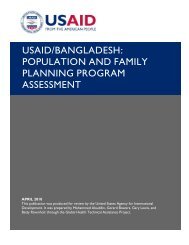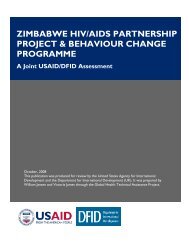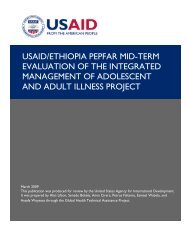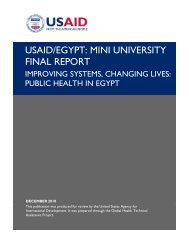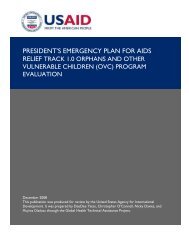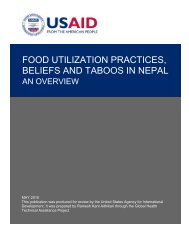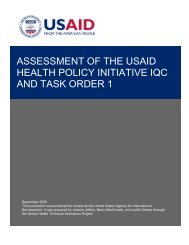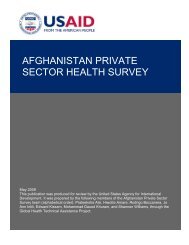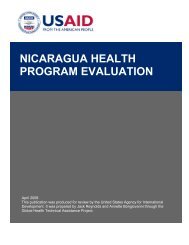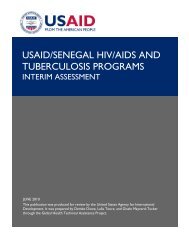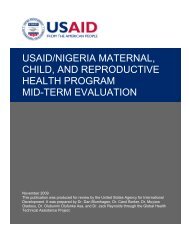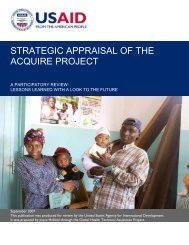Evaluation of the Tuberculosis Control Assistance Program (TB CAP)
Evaluation of the Tuberculosis Control Assistance Program (TB CAP)
Evaluation of the Tuberculosis Control Assistance Program (TB CAP)
Create successful ePaper yourself
Turn your PDF publications into a flip-book with our unique Google optimized e-Paper software.
ANNEX I. SCOPE OF WORKI. IDENTIFICATION OF THE TECHNICAL ASSISTANCEGeneral Description: The U.S. Agency for International Development, Global Health, Office <strong>of</strong> Health,Infectious Diseases and Nutrition (USAID/GH/HIDN) seeks <strong>the</strong> services <strong>of</strong> GH Tech to review <strong>the</strong>performance, impact, and lessons learned <strong>of</strong> <strong>the</strong> <strong>Tuberculosis</strong> <strong>Control</strong> <strong>Assistance</strong> <strong>Program</strong> (<strong>TB</strong> <strong>CAP</strong>), aUSAID-sponsored project formed to control tuberculosis (<strong>TB</strong>) globally.II. BACKGROUND<strong>TB</strong> is an ancient disease that continues to plague millions <strong>of</strong> people each year despite a curable treatmentfor <strong>the</strong> disease. In 2006, <strong>the</strong> World Health Organization (WHO) estimates <strong>the</strong>re were 9.2 million newcases and 1.7 million deaths from <strong>TB</strong>. After a decline in <strong>TB</strong> through <strong>the</strong> late 1980s, <strong>the</strong> global <strong>TB</strong> burdenhas grown alongside <strong>the</strong> HIV epidemic, and HIV-infected patients are at greatly increased risk fordeveloping <strong>TB</strong>. In 2006, an estimated 709,000 <strong>of</strong> <strong>the</strong> new <strong>TB</strong> cases were in HIV-infected patients, and insome African countries more than half <strong>of</strong> new <strong>TB</strong> cases were in HIV-infected patients.<strong>TB</strong> imposes a heavy economic burden in both <strong>the</strong> developed and developing world. Families coping with<strong>TB</strong> lose 20% to 30% <strong>of</strong> <strong>the</strong>ir annual income to <strong>the</strong> disease. Overall, <strong>TB</strong> costs <strong>the</strong> global economy around$12 billion annually.There have been some hopeful signs <strong>of</strong> improving <strong>TB</strong> control in recent years. Although <strong>the</strong> number <strong>of</strong>people developing <strong>TB</strong> continues to rise each year along with <strong>the</strong> global population, <strong>the</strong> estimated rate <strong>of</strong>infection per capita has been fairly stable since 2003. Serious challenges remain, however, including <strong>the</strong>emergence <strong>of</strong> multi-drug-resistant <strong>TB</strong> (MDR-<strong>TB</strong>) and extensively drug-resistant <strong>TB</strong> (XDR-<strong>TB</strong>). Thesestrains have grown resistant to <strong>the</strong> most powerful anti-<strong>TB</strong> drugs due mainly to <strong>the</strong> improper use <strong>of</strong>antibiotics, poor adherence to <strong>TB</strong> treatment, and poor quality drugs.Strategy for <strong>Tuberculosis</strong> <strong>Control</strong>Global <strong>TB</strong> control is guided by <strong>the</strong> Stop <strong>TB</strong> Partnership’s Second Global Plan and <strong>the</strong> World HealthOrganization’s (WHO) Stop <strong>TB</strong> Strategy. In line with <strong>the</strong> Millennium goals, <strong>the</strong> Second Global Plan aimsto halve <strong>TB</strong> prevalence and deaths by 2015 relative to 1990 levels. The Stop <strong>TB</strong> Strategy identifies <strong>the</strong> sixmain components required to achieve <strong>the</strong>se targets, including <strong>the</strong> provision <strong>of</strong> high-quality DOTSexpansion and enhancement; address <strong>TB</strong>/HIV, MDR-<strong>TB</strong>, and o<strong>the</strong>r challenges; contribute to healthsystem streng<strong>the</strong>ning; engage all care providers; empower people with <strong>TB</strong> and communities; and enableand promote research.DOTS is at <strong>the</strong> heart <strong>of</strong> <strong>the</strong> Stop <strong>TB</strong> Strategy. For countries to successfully implement DOTS <strong>the</strong>y mustdemonstrate political commitment to fund and implement an effective national <strong>TB</strong> control program.DOTS also requires an integrated network <strong>of</strong> capable laboratories, surveillance through a standardizedrecording and reporting system, and a robust logistics system that ensures a secure supply <strong>of</strong> drugs. Inaddition, implementation <strong>of</strong> DOTS requires improved access to primary care services that are affordable,equitable, committed, and well-organized. Education and training are essential elements to ensure <strong>the</strong>availability <strong>of</strong> human resources. The WHO established <strong>the</strong> Green Light Committee to help control andprevent MDR-<strong>TB</strong> through access to quality-assured second-line anti-<strong>TB</strong> drugs and prevention <strong>of</strong> <strong>the</strong>development <strong>of</strong> resistance to anti-<strong>TB</strong> drugs by assuring <strong>the</strong> appropriate use <strong>of</strong> <strong>the</strong>se drugs.The <strong>Tuberculosis</strong> <strong>Control</strong> <strong>Assistance</strong> <strong>Program</strong><strong>TB</strong> <strong>CAP</strong> is a five-year $150 million ceiling cooperative agreement competed by USAID.USAID/GH/HIDN manages <strong>TB</strong> <strong>CAP</strong> in close coordination and collaboration with <strong>the</strong> USAID RegionalBureaus and USAID Missions providing funding. The USAID-designated Cognizant Technical OfficerEVALUATION OF THE TUBERCULOSIS CONTROL ASSISTANCE PROGRAM (<strong>TB</strong> <strong>CAP</strong>) 39



